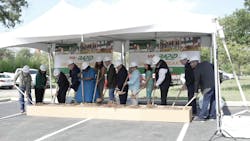VIA Metropolitan Transit breaks ground on Green Line
VIA Metropolitan Transit (VIA) broke ground on the southern portion of the Green Line corridor, the San Antonio, Texas, region’s first Advanced Rapid Transit (ART) route. Work on the Green Line is expected to begin late July, starting with key utility relocation and other grade-level preparations along the 10.4-mile route.
“This project is part of our commitment to deliver on what San Antonians have asked for— better, more reliable and more frequent service,” said VIA President and CEO Jon Gary Herrera. “This isn’t just about infrastructure. It’s about access, about connecting people to opportunity and to the friends, family, places and things that are important to them. The Green Line will do so with the highest frequency and most reliable service.”
Set to begin service in early 2028, the VIA Rapid Green Line will provide enhanced transit access from near the San Antonio International Airport, down San Pedro Avenue, through downtown to Steves Avenue, near the historic missions, with continuing service to the Brooks Transit Center. The Green Line will operate 21 hours a day between 4:00 a.m. and 1:00.a.m., with 10-minute frequencies during the week and 15-minute frequencies on weekends.
“The VIA Rapid Green Line is the culmination of intense community-driven planning, and VIA is now delivering on what our region envisioned for mobility,” said San Antonio Mayor Ron Nirenberg. “Great cities have great public transportation, and I’m excited to see VIA innovating with projects like Advanced Rapid Transit, which is designed to be future-proof and meet the growing and evolving needs of our residents.”
The Green Line is a major component of VIA’s voter-approved Keep San Antonio Moving plan. Funded in part by a one-eighth cent sales tax that VIA will begin receiving in 2026, the project reflects a regional commitment to building a more modern, connected transportation network.
The construction project will be completed in phases, and VIA says it will provide at least 30 days’ notice before construction begins in each segment of the corridor. The agency adds it will continue working closely with residents and businesses to minimize disruptions throughout the construction process. The project’s construction limits are from Isom Road on the north to Steves Avenue on the south.
